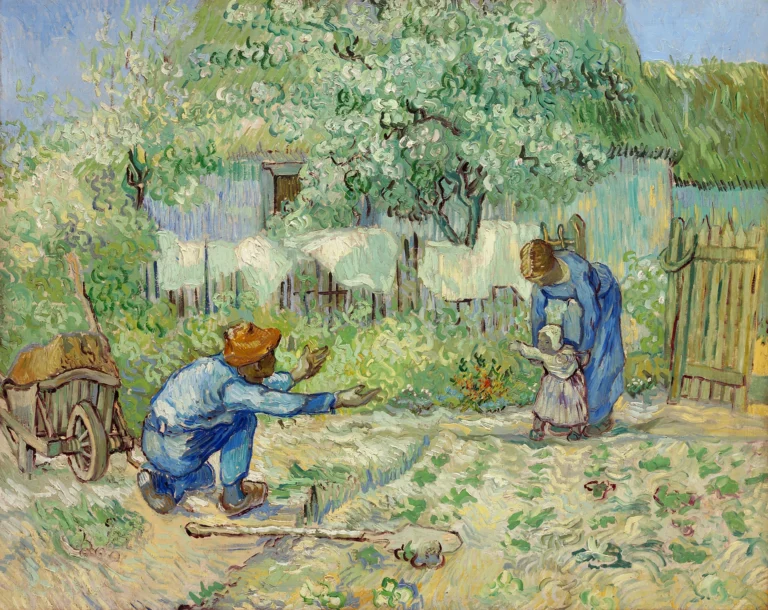First Steps, After Millet (1890)
Vincent van Gogh's First Steps, after Millet is a captivating depiction of a child learning to walk, supported by two figures—a standing woman and a kneeling man. Painted in the January-February of 1890 at the Saint Paul-de-Mausole asylum, the artwork displays Van Gogh's signature Post-Impressionist style, characterized by vivid colors and energetic brushwork. The scene captures not only the essence of familial love but also reflects Van Gogh's fascination with Millet's portrayals of rural life. The use of bright blues and earthy greens creates a lively atmosphere that enhances the joyous moment.
January-February 1890
About the Artwork
This painting was inspired by Jean-François Millet, a rural-themed artist whose work greatly influenced Van Gogh. During his recovery at the asylum, Van Gogh found solace in creating copies of Millet's paintings, which helped him express his artistic voice despite his confinement. The original photograph of Millet's work, sent by his brother Theo, acted as a reference for Van Gogh, who adeptly infused the scene with his unique interpretations of color and emotion. This piece symbolizes not just a moment of growth for the child, but also reflects Van Gogh’s personal journey of healing and artistic discovery at an emotionally turbulent time in his life.
Did You Know
Liked what you see? Add it to your collection.
Enjoyed reading? Share it.
... continued
Inspiration and Influence
The painting is a copy of a work by the French artist Jean-François Millet, whom Van Gogh greatly admired. Van Gogh often created copies of Millet's works during his confinement, as he had limited access to models and was deeply influenced by Millet's focus on everyday life scenes.
Technique and Style
The painting is an oil on canvas, measuring 72.4 x 91.1 cm. It exemplifies Van Gogh's Post-Impressionist style, characterized by vibrant, textured brushwork and bold, expressive strokes. The scene depicts a child taking its first steps, supported by a standing woman and encouraged by a kneeling man, set against a lively and verdant background. The figures are dressed in striking blue and white, contrasting with the yellowish-green hues of the foliage.
Creation Process
Van Gogh used a photograph of Millet's original work, sent by his brother Theo, as a reference. He would often square up these photographs and transfer them to the canvas before improvising with color, treating these copies as "translations" similar to a musician's interpretation of a composer's work.
Provenance
The painting has had several owners since its creation. It was initially sent to Theo van Gogh in Paris on April 29, 1890. It later passed through various collectors, including Karl Ernst Osthaus, Alfred Flechtheim Art Gallery, and Julius Oppenheimer, before being gifted to the Metropolitan Museum of Art in New York City by Mr. and Mrs. George N. Richard in 1964.
Current Location
The painting is currently housed at the Metropolitan Museum of Art in New York City, where it remains part of the museum's collection.










